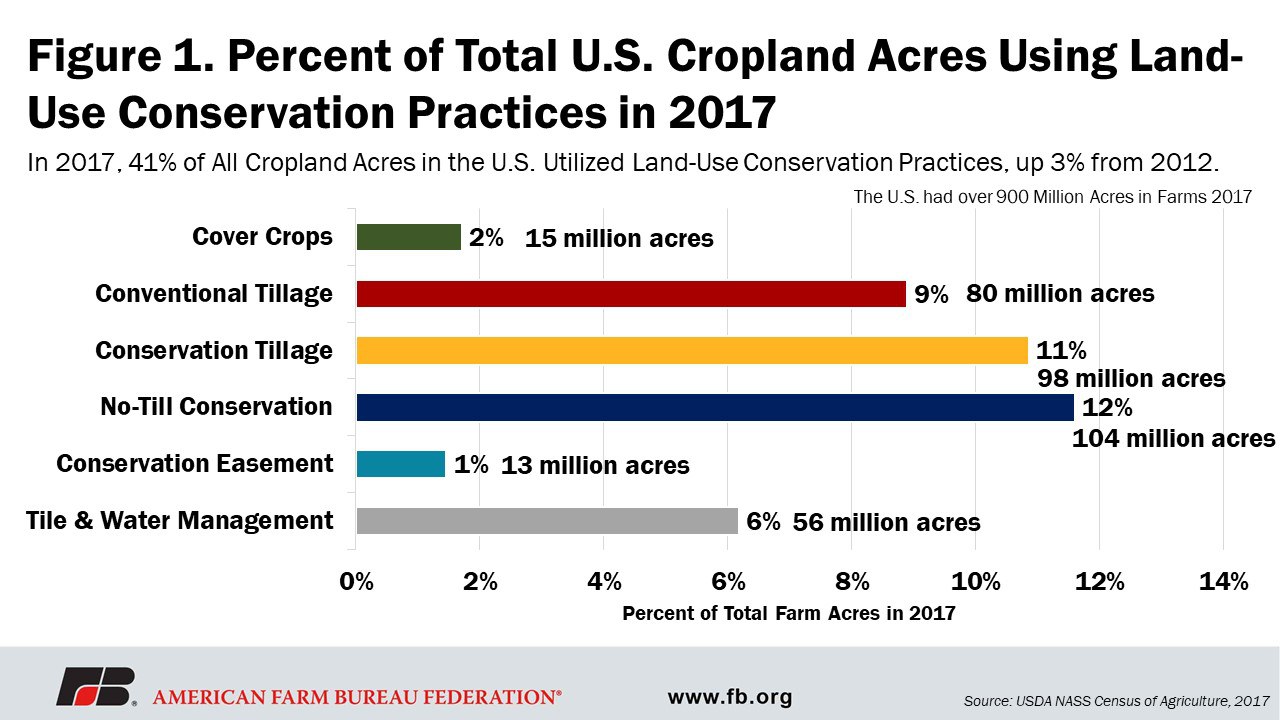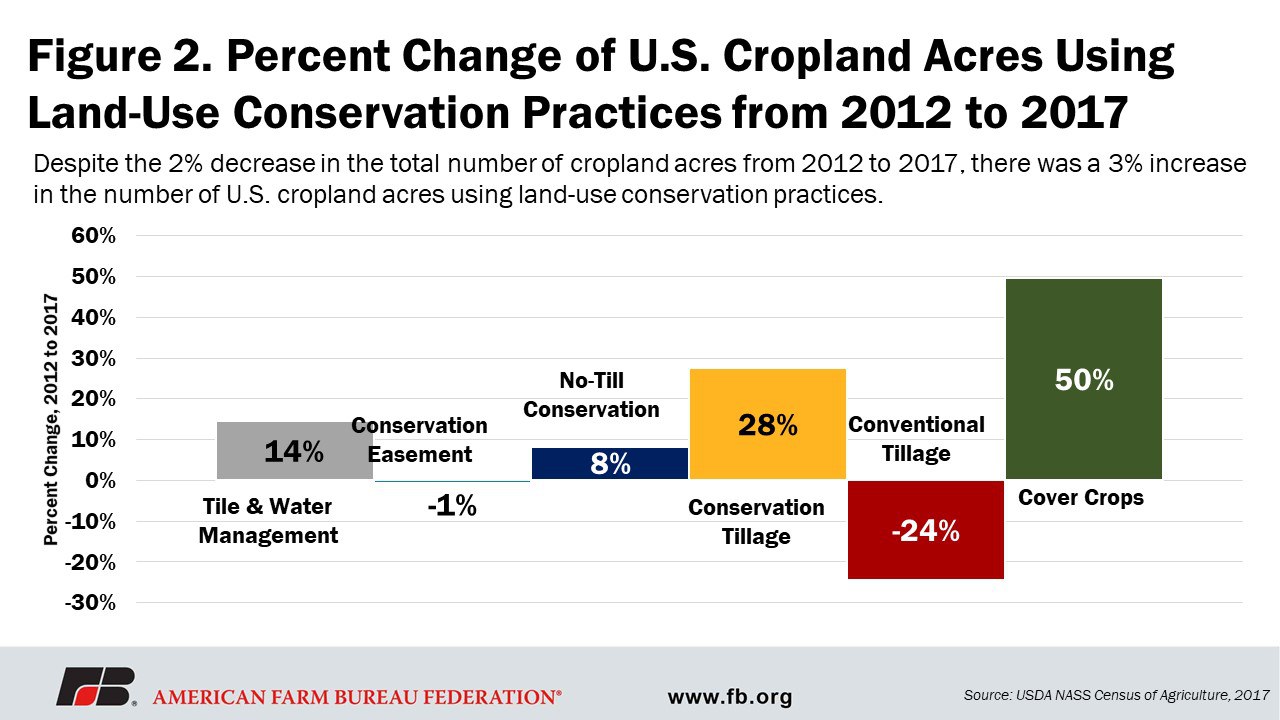Sustainability Markets, Part 2: Common Land-Use Practices Under Consideration for Conservation Adoption
TOPICS
SustainabilityShelby Myers
Economist

photo credit: AFBF Photo, Morgan Walker
Shelby Myers
Economist
This Market Intel article is the second in a five-part series highlighting agricultural ecosystem credit markets and the opportunities and challenges they present farmers, as well as the policy levers and many other factors involved. The first article, Sustainability Markets, Part 1: Agricultural Ecosystem Credit Markets – The Primer, provided a primer on agricultural ecosystem credit markets, how the markets are developing and operating and who is behind them and why.
This Market Intel article discusses some of the Natural Resources Conservation Service’s conservation practices commonly utilized in agricultural ecosystem credit market contracts and their current adoption rates.
These NRCS conservation practices are used to improve soil health, reduce soil erosion, improve water quality and provide other natural resource benefits.
To maintain basic soil health, NRCS calls on farmers to keep the soil covered, disturb the soil minimally, keep a living cover that feeds the soil throughout the year, diversify crop systems on the soil through crop rotations and cover crops and incorporate livestock into the cropping system. Many of these practices contribute to carbon sequestration, as well as nutrient reduction and water quality/water quantity improvements.
Cover Crops and Livestock Grazing
Cover crops like grasses, legumes and forbs can provide conservation cover if planted before grain crops are harvested or immediately after harvest. Depending on the cover crop mix planted, cover crops can reduce soil erosion and trap and sequester nutrients, like carbon, in the soil. Cover crops have also been used to improve soil biology, reduce weed competition, improve water infiltration and increase organic matter in soil. Cover crops are especially helpful when incorporating livestock grazing into a cropping system, providing an added nutrition source.
NRCS has Field Office Technical Guides for each state. The localized guides are scientific references containing technical information about conservation, including cover crops.
Crop Rotation
Beyond the market incentives, reasons for planting different crops each year include improved soil health and enhanced biological diversity. In addition, crop rotation can reduce soil erosion and reduce pesticide costs, while also improving water quality. If a farmer incorporates a rotation of alfalfa and other legumes, there are fertilizer reduction benefits, as well.
No-till/ Strip-till/ Conservation Tillage
Soil compaction is a constant challenge for farmers post-harvest and moving into the following year’s planting, but limiting disturbances to the soil improves carbon retention and minimizes carbon emissions from soils. Avoiding full-width tillage, regardless of the depth or timing, if done long-term, can add organic matter to the soil as it decomposes and help to reduce soil compaction. Avoiding full-width tillage reduces soil erosion and protects water quality since the soil is not disrupted and can help keep water available for plants into the growing season after planting. Overall, the reduction in soil disturbance creates fewer inputs ahead of planting the crop.
Anaerobic Digester
An anaerobic digester takes organic matter, such as livestock manure, and breaks it down to produce biogas and biofertilizer. When captured, the biogas reduces methane and greenhouse gas emissions that would be released into the atmosphere otherwise. By capturing the biogas, it can also be used to generate electricity or used as a natural gas energy stream, which is a renewable energy source.
Management of the solid and liquid waste streams that enter an anaerobic digester can further maximize the digester’s efficiency and make available more methane for capture and combustion.
Nutrient Management
Precisely managing - through precision technology, for example -- the source, rate, timing and placement of nutrients like nitrogen or animal manure as fertilizer can reduce the potential for waste or runoff of plant nutrients, which can improve soil conditions and overall crop production, prevent excess nitrogen runoff and reduce input costs. Think the 4R's: right source, right rate, right time and right place can help keep nutrients on and in the field.
Buffer Strips
These strips of grass, mixed grasses and legumes run along the contour of a farmed field to create a “buffer.” Buffer strips made up of native plants and grasses remove sediment, nutrients and pesticides as they pass through, all while helping reduce soil erosion. Buffer strips can also provide habitats for pollinators and other beneficial insects.
Tree/Shrub Establishment
Adding compatible trees and shrubs to pastureland or around livestock buildings and establishing woody plants could reduce soil erosion and improve air and water quality. Additional trees and shrubs provide wildlife habitat that can also store carbon and be used as biomass for energy.
Adoption of Conservation Practices
Available data regarding conservation adoption and the practices used on farms is limited due to the privacy of individual farmers and the limited resources USDA has for conducting surveys. Taken only once every five years, the 2017 USDA Census of Agriculture is a survey-based count of U.S. farms and ranches and the people who operate them. The survey looks at land use and ownership, operator characteristics, production practices, income and expenditures. The Census of Agriculture provides the most recent data regarding land use practices by the number of farms and the number of acres. In 2017, there were over 900 million acres in farmland. Of the 900 million acres, 366 million acres, or 41 %, used tile and water management, conservation easement, no-till conservation, conservation tillage, conventional tillage or cover crops, which is an increase of 3% from the number of acres utilizing these practices in 2012. Figure 1 displays the percent of cropland acres utilizing each of the surveyed land-use conservation practices.

When compared to 2012 when the Census of Agriculture was previously published, the land-use practices aligned with the NRCS conservation practices that improve soil health, reduce soil erosion, improve water quality and provide other natural resource benefits increased in adoption. Conventional tillage was reduced by 24% from 2012 to 2017, while no-till conservation and conservation tillage increased by 8% and 28%, respectively. Cover crops increased by 50%. Figure 2 shows the percent change of U.S. cropland acres utilizing certain land-use practices from 2012 to 2017.

While NRCS has resources and information related to conservation practices used to improve soil health, reduce soil erosion, improve water quality and provide other natural resource benefits, adoption rates on U.S. cropland have been limited due to a variety of barriers. This Market Intel series will analyze those barriers in the third article. Though adoption rates may be low, the most recent data shows the pace in which farms have adopted conservation practices has increased, indicating many farms have been able to implement some version of conservation on their acres.
The third article Market Intel in this series will share some of the challenges barring ecosystem credit market participation that farmers and ranchers could face if they are not addressed or resolved explicitly by market operators or policy makers.
Trending Topics
VIEW ALL